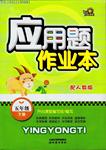题目内容
Can you imagine a classroom without one thing that has long been considered a necessary part? No notebooks, no textbooks, no test papers. Nor are there any pencils or pens, which always seem to run out of ink at the critical moment.
A “Paperless classroom” is what more and more schools are trying to realize. Students don’t do any handwriting in this class. Instead, they use hand-sized or specially-designed computers. The teacher downloads texts from Internet libraries and sends them to every student’s personal computer.
Having computers also means that students can use the Web. They can look up information on any subject they’re studying, from maths to social science.
A high school teacher, Judy Herrel in Florida, US, described how her class used the Web. “Using a book that’s three or four years old is impossible,” she said.
A paperless classroom is a big step towards reducing the waste of paper.
“Think about the money and trees we could save with the computers,” she said.
But, with all this technology, there’s always a risk that the machines will break down. So, in case of a power failure or a technical problem, paper textbooks should still be widely available (可得到的) for these students
- 1.
The underlined word “critical” in the first paragraph probably has the same meaning as _______
- A.worrying
- B.dangerous
- C.happy
- D.important
- A.
- 2.
You are sure to find __________ in a paperless classroom
- A.pens
- B.computers
- C.test papers
- D.notebooks
- A.
- 3.
According to Judy Herrel, __________
- A.the Web can talk the students everywhere
- B.the Web can take the place of teachers
- C.the Web is a better tool for information
- D.the Web is for downloading information
- A.
- 4.
The paper textbooks should still be widely available because __________
- A.students won’t have trouble with their pens
- B.computers may break down sometimes
- C.students may not get all information from the Internet
- D.paper textbooks may give students more information
- A.
DBCB
1.第一段最后一句为which always seem to run out of ink at the critical moment.所表示的含义为应该为似乎总是在最关键的时候用完了墨水,所以critical单词的意思最接近重要的意思,故本题选D。
2.本文第二段第二句为they use hand-sized or specially-designed computers.所表示的含义为在无纸的课堂需要电脑,故本题选B。
3.本文第三段第一句为Having computers also means that students can use the Web. They can look up information on any subject they’re studying,所表示的含义为所表示的含义为网页为我们查找有关学习的信息提供了更好的工具,故本题选C。
4.本文最后一段提到电脑有时会被摔坏,所以纸课本应该仍然被广泛的使用,故本题选B。
1.第一段最后一句为which always seem to run out of ink at the critical moment.所表示的含义为应该为似乎总是在最关键的时候用完了墨水,所以critical单词的意思最接近重要的意思,故本题选D。
2.本文第二段第二句为they use hand-sized or specially-designed computers.所表示的含义为在无纸的课堂需要电脑,故本题选B。
3.本文第三段第一句为Having computers also means that students can use the Web. They can look up information on any subject they’re studying,所表示的含义为所表示的含义为网页为我们查找有关学习的信息提供了更好的工具,故本题选C。
4.本文最后一段提到电脑有时会被摔坏,所以纸课本应该仍然被广泛的使用,故本题选B。

练习册系列答案
 应用题作业本系列答案
应用题作业本系列答案
相关题目
| 从方框中选择适当的句子完成对话,其中有两项为多余选项。 | |
Daming : _l Weihua:I think it's not very interesting. Why are you going there? Daming : _2 Weihua : Wow ,I think you are a good brother. Daming : Of course ! 3 Weihua :I'm going to China National Film Museum(中国电影博物馆 ) . Daming: 4 Weihua: Yes,I can. There are lots of films for children. Daming: Wow!That's great ! 5 Weihua:Im going to take bus No. 402. Daming: Oh,I know. You can take bus No. 418, too. Weihua: Yes, you are right. |